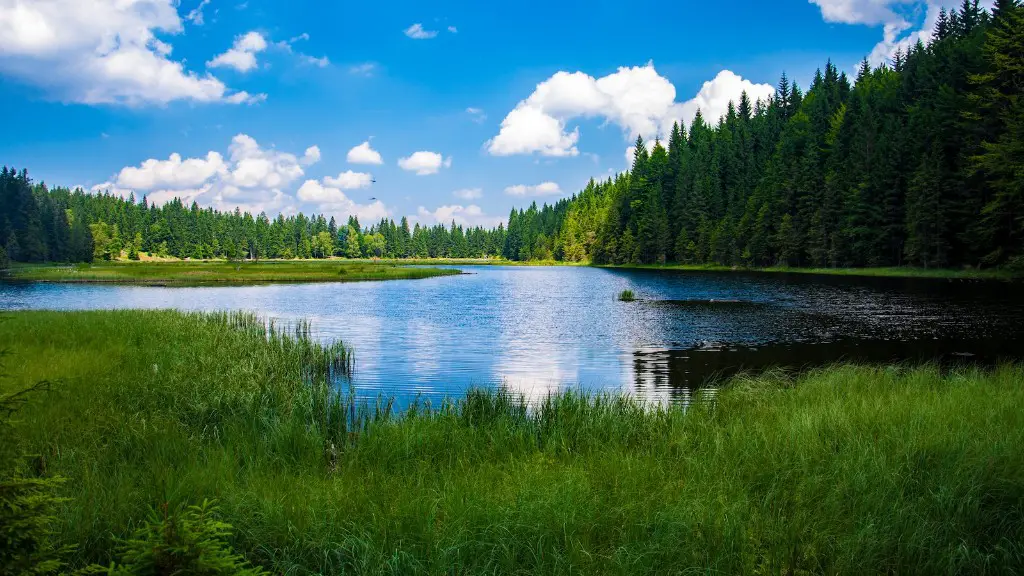What Fish Are In Lake Huron
The Lake Huron Basin hails from the fifth Great Lake of North America, the second largest of the Great Lakes. This basin is home to over 160 species of fish, each of which bring their own interesting traits and characteristics to the area. From world-class walleye fishing to the hard-fighting lake trout, here is a look at some of the fish that live in Lake Huron.
Walleye
Walleye are the dream catch of many Lake Huron fishermen. They are often true monsters of this aquatic wilderness that can exceed 10 pounds. Bait fishing with minnows, worms, crankbaits and spinners are all effective ways to target these fish. Although they tend to bite best on the sunrise, they can be caught throughout the day in the shallow bays and reefs in the lake.
Lake Trout
The lake trout is one of the premier gamefish of the Great Lakes. They inhabit the deep, cold waters of Lake Huron and play an important role in the lake’s ecology. These fish can reach lengths of 2 feet and can weigh up to 20 pounds. Due to their size and tenacity, lake trout are the prized trophy of Lake Huron anglers. The most popular method for targeting lake trout is trolling, as they are often reluctant to take baits off the bottom.
Smallmouth Bass
Smallmouth bass are renowned for their explosive strikes and feisty fights. While these fish are smaller than the lake trout and walleye they’re still considered one of the top sportfish throughout the lake. Most anglers target them with a spinnerbait or a soft plastic bait, and they’re often found in the shallow areas of Lake Huron. Smallmouth bass are a favorite gamefish of many Lake Huron anglers, and they’re often found in the harbor, bays and coves at the mouth of the lake.
Muskellunge
Sometimes referred to as Muskies, muskellunge are one of the top predators in the Great Lakes. These fish can reach lengths of up to 7 feet in length, and they’re considered one of the most sought-after gamefish in Lake Huron. Muskellunge are extremely hard fighters and can put up an impressive fight for a fisherman who’s lucky enough to catch one. Despite their size, muskie can be found in shallow waters and are often targeted in the harbor and bays.
Yellow Perch
Yellow perch are the quintessential perch of the Great Lakes, and they’re an important part of Lake Huron’s fishing ecosystem. These small fish are extremely tasty and are often used as bait for larger gamefish. Perch can be caught on almost any bait or lure, and they’re often found in the shallow bays and coves of Lake Huron. Many anglers target yellow perch with worms and leeches for the best chance of success.
Cisco
Cisco are another popular gamefish of the Great Lakes, and they’re often found in Lake Huron. Cisco are a schooling species and they’re often found in schools of 10 to 100 fish. These fish are also known as freshwater herring, and they can be caught on lures or small baits. Trolling is often the most successful method for catching cisco, and they’re often found in the deeper waters of the lake.
Whitefish
Whitefish are another popular species of the Great Lakes, and they’re often found in Lake Huron. Whitefish are often considered the holy grail of Lake Huron fishermen, and they can reach lengths of up to 3 feet. These fish are generally bottom-feeding fish, and they can be caught on a variety of baits and lures. Fly-fishing is a popular method used for catching whitefish, and they’re often found in deeper waters of the lake.
Conservation Status
While Lake Huron is home to many species of fish, some species have experienced declines in their populations due to habitat loss, pollution, overfishing, and the introduction of invasive species. As a result, the Lake Huron Basin Fishery Advisory Commission has been formed to ensure that the populations of fish in the lake remain stable. The Commission works with scientists, conservationists and anglers to monitor fish populations and ensure the lake’s health.
Toxic Algae
One of the biggest threats to the health of the Lake Huron Basin is algae blooms. These blooms can occur when excess nutrients enter the lake and cause rapid growth of algae. As the algae blooms, they deprive the lake of oxygen and can kill off large amounts of fish and other aquatic life. The Commission has been working closely with local, state and federal agencies to monitor and control algae blooms in the lake and protect the fish populations.
Phosphorus Pollution
Another major issue impacting the fish populations of Lake Huron is phosphorus pollution. Phosphorus pollution is caused by runoff from agricultural and urban sources, and phosphorus runoff can be devastating to fish populations. The Commission has been working closely with partner organizations to reduce phosphorus runoff in Lake Huron to prevent further damage to the habitat.
Angler Education
The Commission also works closely with local fishing groups and anglers to provide education and training on fishing practices and techniques. Angler education is a key factor in ensuring that fish populations remain healthy and that the lake’s ecosystems remain intact. By educating anglers on proper fishing practices, the Commission is helping ensure the health of Lake Huron’s fish populations.
Recreation
Fishing is a major industry in the Lake Huron Basin, and the Commission works closely with local and state agencies to ensure the health of the lake’s fisheries. The Commission has been working to promote recreational fishing in the lake by providing maps and other resources for anglers looking to explore the lake’s fisheries. Additionally, the Commission is actively working to expand access to the lake’s public fishing areas and to promote responsible fishing practices on the lake.
Fish Species
Lake Huron is home to over 160 species of fish, from the renowned walleye to the hard-fighting lake trout. Most species of fish inhabit deeper, cooler waters of the lake, though some can make their way into the shallows. While pollution and overfishing continue to threaten the health of the lake’s fisheries, the Commission is actively working to protect the lake’s fish populations and ensure the health of the basin.
Native Species
Lake Huron is also home to many native species of fish, from the lake sturgeon to the longnose gar. The Commission actively works to protect these species from harm by monitoring their populations and habitat. Additionally, the Commission encourages anglers to practice responsible fishing practices and to release native species as soon as possible to ensure their health and well-being. Through their efforts, the Commission is helping to ensure that native species remain a thriving part of the lake’s ecosystem.
Invasive Species
Unfortunately, Lake Huron is also home to a number of invasive species. Species such as the zebra mussel and Asian carp can dramatically disrupt the lake’s ecosystem, as they compete with native fishes for food and habitat. The Commission works closely with local, state and federal agencies to monitor and control these invasive species and to protect the lake’s native fish populations.
Conclusion
Lake Huron is home to a variety of fish species, from the renowned walleye to the longnose gar. While several factors have threatened the health of the lake’s fisheries, the Lake Huron Basin Fishery Advisory Commission is actively working to protect fish populations and ensure the health of the lake’s ecosystems. Through their efforts, the Commission is helping to ensure the health of Lake Huron’s fisheries and the recreational opportunities of anglers.




